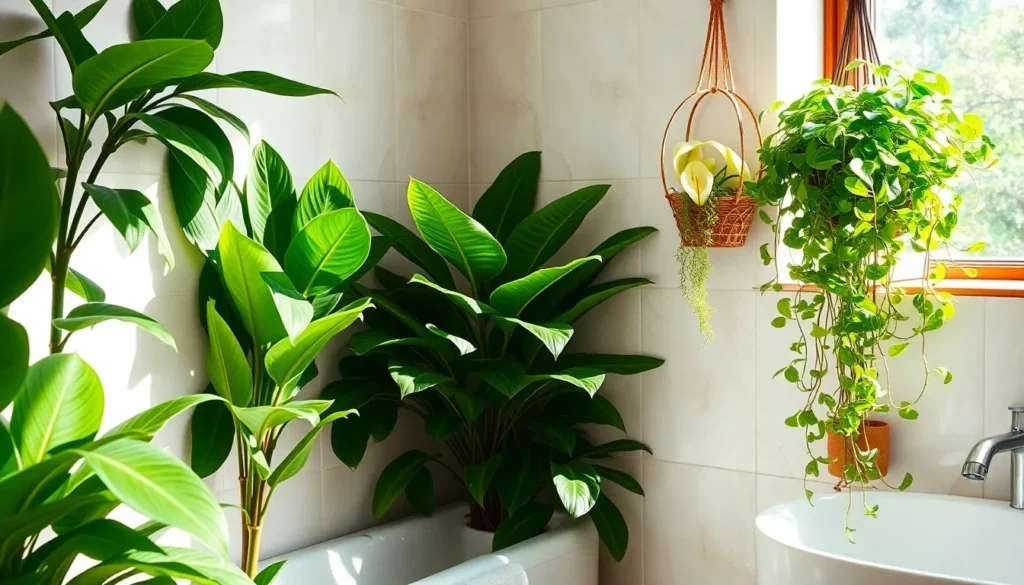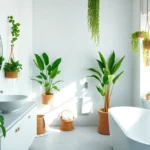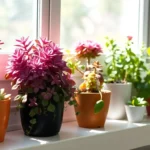We’ve all faced the battle against excess moisture in our bathrooms. Steam from hot showers, poor ventilation, and constant humidity create the perfect breeding ground for mold and unpleasant odors. While exhaust fans help, they’re not always enough to tackle persistent dampness issues.
What if we told you there’s a natural, beautiful solution that’ll transform your bathroom into a spa-like oasis? Certain plants act as living dehumidifiers, naturally absorbing moisture from the air while adding a fresh, vibrant touch to your space. These green powerhouses don’t just look stunning – they actively work to reduce humidity levels and improve air quality.
The best part? You don’t need a green thumb to succeed. We’ve discovered moisture-loving plants that thrive in bathroom conditions, requiring minimal care while delivering maximum benefits. Ready to discover which plants will revolutionize your bathroom’s atmosphere and say goodbye to foggy mirrors and musty smells forever?
Snake Plant: The Ultimate Humidity Fighter
We’ve found the perfect bathroom companion that combines moisture absorption with stunning visual appeal. Snake plants excel at removing excess humidity while requiring minimal maintenance effort.
Natural Air Purification Benefits
Snake plants naturally filter harmful toxins from bathroom air while simultaneously absorbing moisture through their thick succulent leaves. These remarkable plants remove formaldehyde, benzene, and xylene commonly found in cleaning products and personal care items. Studies show snake plants can absorb up to 107 different air pollutants, making them exceptional choices for enclosed bathroom spaces.
The plant’s unique crassulacean acid metabolism process allows it to release oxygen at night, unlike most plants that only produce oxygen during daylight hours. This nighttime oxygen production creates fresher air quality throughout your bathroom’s most humid periods.
Low Light Tolerance Perfect for Bathrooms
Bathrooms typically receive limited natural light, but snake plants thrive in these dimly lit conditions without losing their vibrant appearance or moisture absorbing capabilities. We recommend placing them in corners or windowless bathrooms where other plants would struggle to survive.
These hardy plants adapt to fluorescent bathroom lighting and can flourish under LED fixtures commonly installed in modern bathrooms. Their tolerance extends to spaces receiving as little as 200 foot-candles of light, which covers most residential bathroom lighting scenarios.
Minimal Watering Requirements
Snake plants require watering only once every 2-4 weeks, making them ideal for busy homeowners who might forget regular plant maintenance. Their thick leaves store water efficiently, preventing root rot issues common in humid bathroom environments.
We suggest checking soil moisture by inserting your finger one inch deep into the potting mix. Water only when the top inch feels completely dry to the touch. Overwatering poses more risk than underwatering for these drought-tolerant humidity fighters.
Boston Fern: Nature’s Moisture Magnet
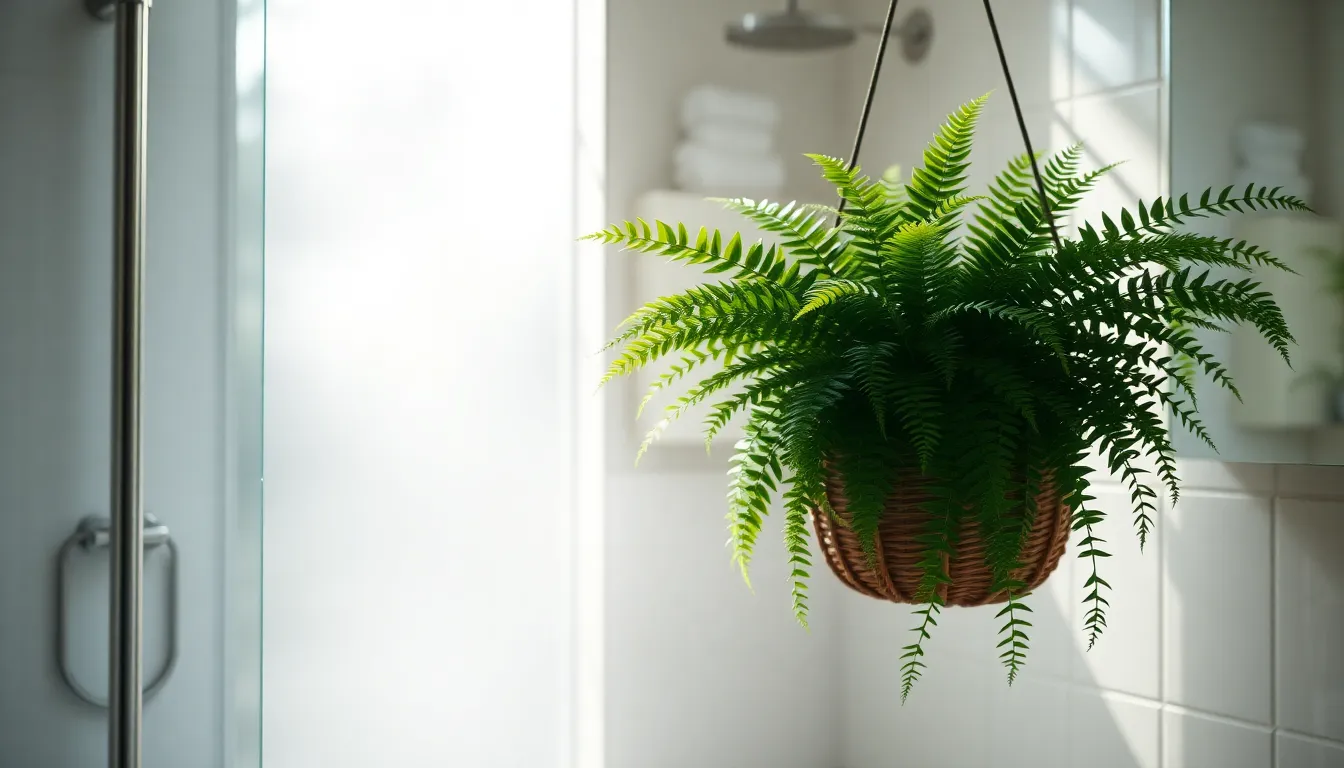
Boston Ferns stand out as exceptional bathroom companions that naturally combat excess humidity while adding lush tropical beauty to your space.
Exceptional Humidity Absorption Capabilities
Boston Ferns absorb important amounts of moisture from the air through their delicate, lacy fronds, making them powerful natural dehumidifiers for bathrooms. We can rely on these tropical plants to reduce excess humidity that often leads to mold and mildew growth in enclosed bathroom spaces. Their leaves serve as natural moisture indicators, turning yellow when humidity levels drop too low and signaling when we need to increase misting or adjust placement. Beyond moisture control, these ferns filter airborne toxins from the atmosphere, creating fresher and healthier bathroom environments for our daily routines.
Thriving in High-Moisture Environments
Nephrolepis exaltata originates from tropical, humid climates where consistent moisture levels create ideal growing conditions. We’ll find these plants flourish in bathroom environments where shower steam and bath humidity provide the perfect atmospheric conditions they crave. Regular exposure to moist air from our daily bathing routines keeps Boston Ferns vibrant and healthy without requiring complex care regimens. Their natural affinity for humid spaces means they actually prefer bathroom conditions over drier household locations.
Hanging Basket Display Options
Hanging baskets maximize Boston Ferns’ moisture absorption potential by positioning their cascading fronds throughout the room’s humid air currents. We can create stunning visual displays by suspending these plants near shower areas where steam circulation is highest. Their lush fronds cascade beautifully from elevated positions, adding dramatic tropical appeal while maintaining optimal exposure to bathroom humidity. Placement in indirect sunlight or shaded bathroom corners prevents leaf burn while ensuring healthy growth and consistent moisture absorption performance.
Spider Plant: Easy-Care Moisture Absorber
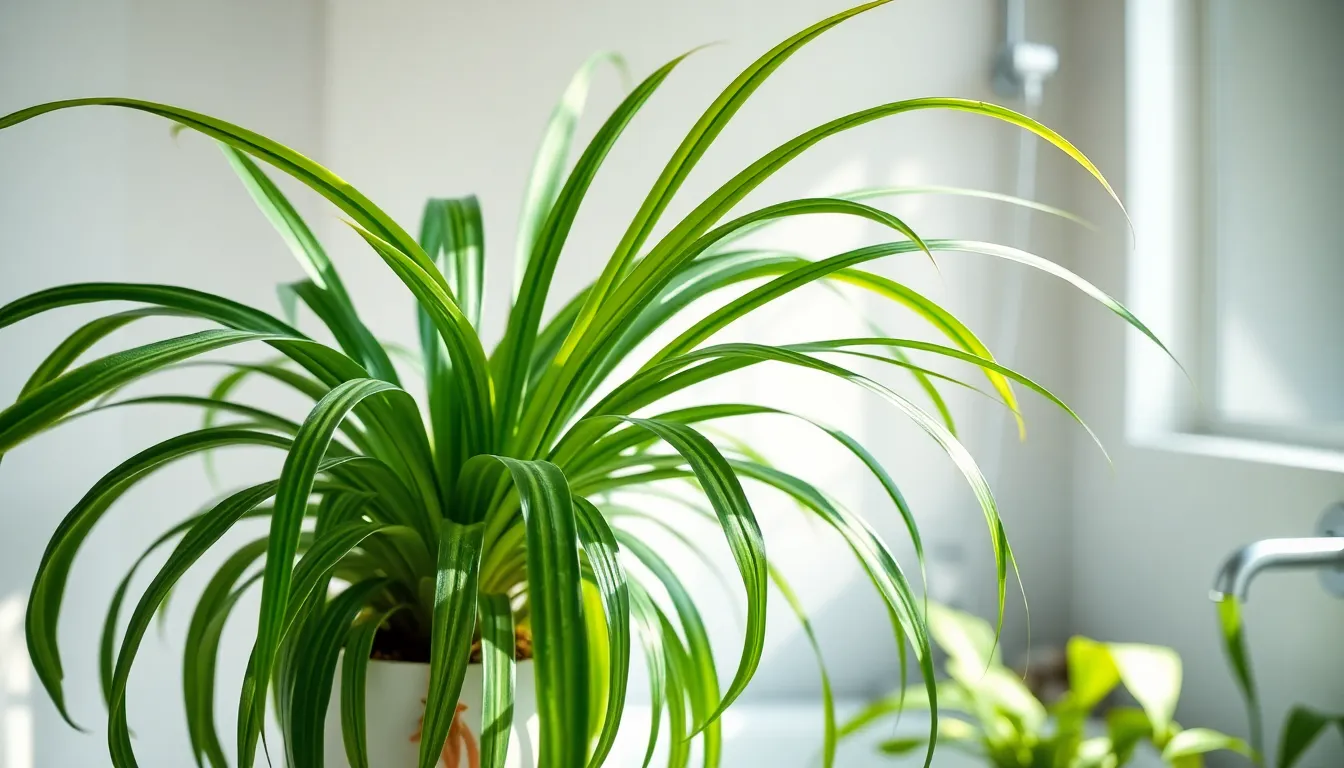
Spider plants (Chlorophytum comosum) offer another fantastic solution for moisture control while adding vibrant greenery to your bathroom space. These adaptable plants thrive in humid environments and require minimal maintenance, making them perfect for busy homeowners.
Rapid Growth in Humid Conditions
Accelerated development occurs when spider plants encounter the steamy conditions typical of bathroom environments. We’ve observed that these plants flourish in humidity levels created by daily showers and baths, absorbing moisture efficiently through their arching green leaves. Fast growth rates enable spider plants to process more airborne moisture as they expand their foliage coverage.
Moisture absorption increases dramatically as spider plants develop their characteristic long, slender leaves. Bathroom humidity provides the ideal growing conditions these plants crave, allowing them to reach their full moisture absorbing potential quickly. Growth spurts happen naturally when these plants encounter consistent steam and humidity levels.
Propagation Benefits for Multiple Bathrooms
Baby plants or offshoots develop naturally from mature spider plants, creating new moisture absorbing opportunities throughout your home. We can easily propagate these “babies” by placing them in water until roots form, then transplanting them to soil. Multiplication benefits extend your moisture control capabilities to guest bathrooms, powder rooms, and other humid areas.
Expansion potential allows us to create a network of moisture absorbing plants without purchasing additional specimens. Each mature spider plant produces multiple offshoots that can establish independent root systems. Cost effective propagation means we can outfit multiple bathrooms with these beneficial plants using just one original purchase.
Air Quality Improvement Properties
Pollutant filtration capabilities make spider plants valuable beyond simple moisture absorption, as they actively remove airborne contaminants from bathroom air. We benefit from their ability to process various toxins and pollutants that accumulate in enclosed bathroom spaces. Enhanced air quality results from the plant’s natural filtering system working continuously.
Mold prevention occurs when spider plants reduce excess humidity that typically leads to mildew and fungal growth. These plants create healthier bathroom environments by maintaining optimal moisture levels while purifying the surrounding air. Atmospheric improvements include reduced risks of respiratory irritation and improved overall air freshness in your bathroom space.
Peace Lily: Elegant Humidity Control
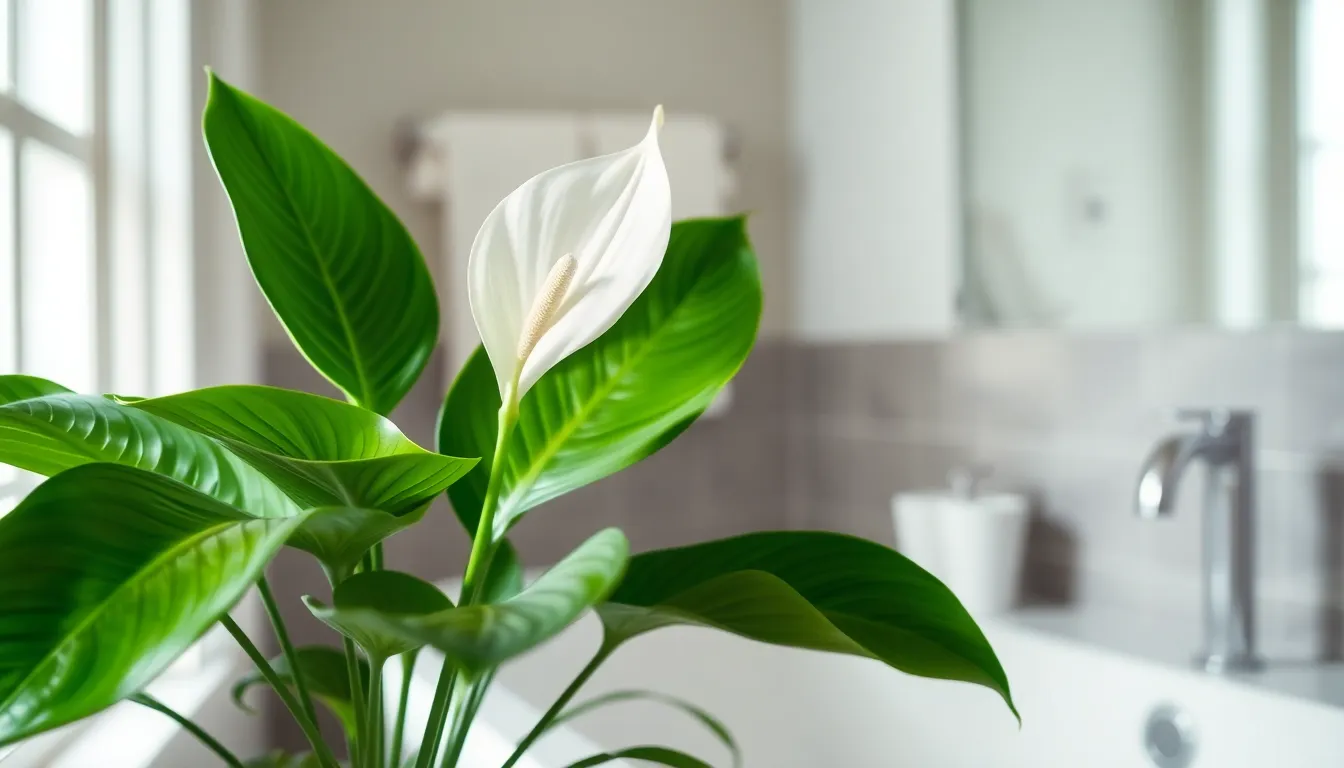
We’ve discovered that the Peace Lily (Spathiphyllum wallisii) stands as one of the most sophisticated bathroom plants for moisture absorption. This remarkable plant combines functional humidity control with stunning visual appeal, making it perfect for creating an elegant bathroom oasis.
Beautiful White Blooms in Steamy Bathrooms
Peace Lilies produce stunning white blooms that add a decorative touch to steamy bathroom spaces. These elegant flowers thrive in the humid conditions typical of bathrooms, creating a spa-like atmosphere while actively working to control moisture levels. The plant’s sophisticated appearance transforms ordinary bathrooms into luxurious retreats, with its glossy green foliage providing a beautiful backdrop for the pristine white spathes.
Steamy environments actually encourage more abundant blossoming when the Peace Lily receives indirect sunlight near a bathroom window. We love how these plants maintain their ornamental value while serving as natural dehumidifiers, absorbing excess moisture through their broad leaves to reduce condensation on bathroom surfaces.
Indication of Watering Needs Through Drooping
Drooping leaves serve as the Peace Lily’s built-in watering indicator, making plant care incredibly straightforward for bathroom gardeners. When the soil begins drying out, the plant’s leaves will visibly droop, signaling it’s time for watering without any guesswork involved. This natural communication system prevents both overwatering and underwatering, which are common concerns in humid bathroom environments.
We appreciate how this clear visual cue eliminates the need for moisture meters or complex watering schedules. The drooping mechanism works reliably regardless of bathroom humidity levels, ensuring your Peace Lily receives appropriate care while continuing its moisture absorption duties.
Excellent Low-Light Performance
Low-light conditions don’t hinder the Peace Lily’s ability to absorb moisture and purify bathroom air effectively. These adaptable plants perform exceptionally well in dimly lit bathrooms, where many other houseplants would struggle to survive. The Peace Lily’s tolerance for minimal lighting makes it ideal for windowless bathrooms or spaces with limited natural light exposure.
Even in challenging lighting conditions, Peace Lilies continue removing toxins from the air while controlling humidity levels through their efficient moisture absorption system. We recommend positioning them away from cold drafts and temperature fluctuations to maintain their consistent performance in low-light bathroom environments.
Bamboo Palm: Tropical Moisture Manager
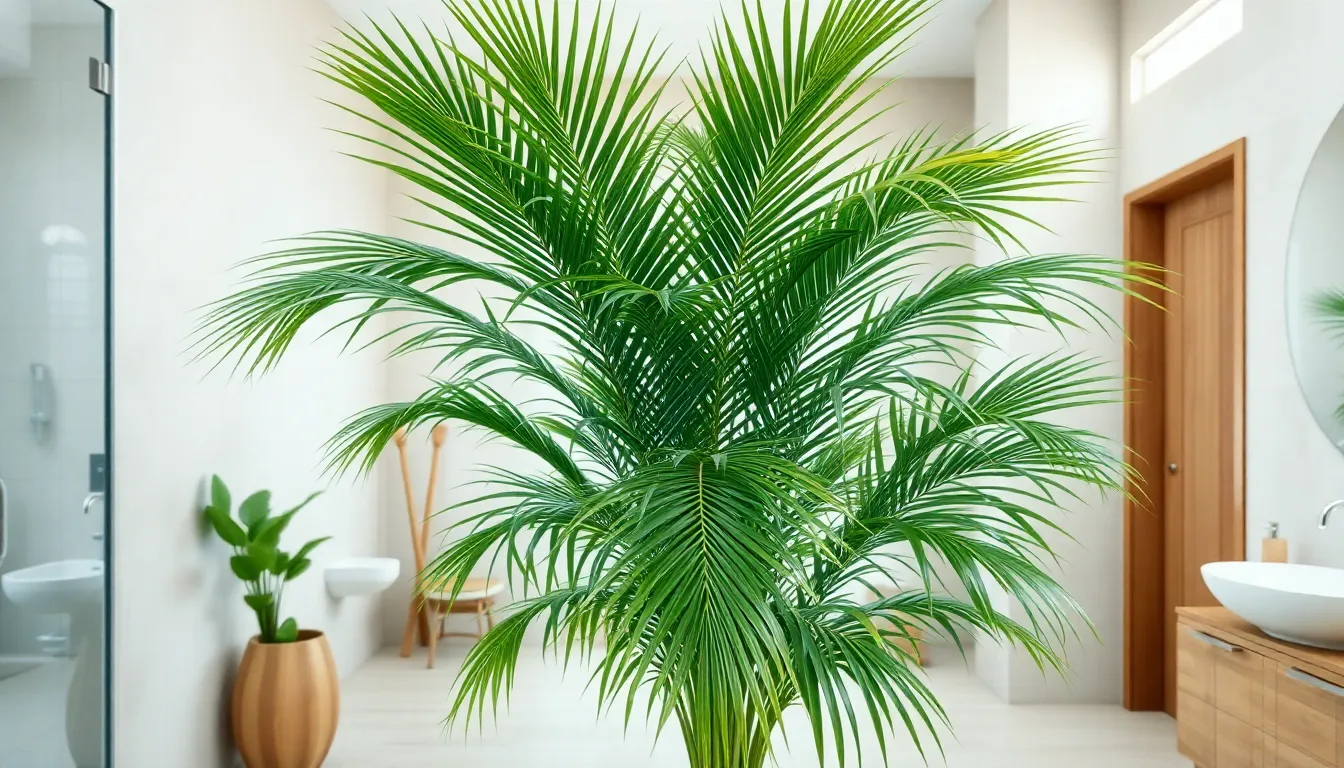
We’re introducing the Bamboo Palm as our next tropical powerhouse for bathroom moisture control. This remarkable plant brings both functionality and exotic beauty to your humid bathroom environment.
Large Surface Area for Maximum Absorption
Bamboo Palms feature extensive leaf surfaces that efficiently capture moisture from bathroom air. Their broad fronds create an impressive surface area that works continuously to absorb excess humidity. We’ve found that these tropical plants excel at managing moisture levels through their naturally large foliage structure.
The plant’s expansive leaves act like natural moisture magnets, drawing humidity from the surrounding air. Each frond contributes to the overall absorption capacity, making the Bamboo Palm particularly effective in steamy bathroom conditions. We recommend positioning these plants where their large leaves can access maximum air circulation for optimal moisture management.
Natural Humidifier Alternative
Bamboo Palms serve as living alternatives to mechanical humidifiers by regulating bathroom moisture naturally. These plants automatically adjust to your bathroom’s humidity levels, absorbing excess moisture when conditions become too damp. We appreciate how they provide consistent moisture control without requiring electricity or maintenance like traditional humidifiers.
Their natural humidity regulation helps prevent mold and mildew growth that commonly occurs in poorly ventilated bathrooms. The plant’s tropical origins mean it thrives in the moist conditions that would damage other houseplants. We’ve observed that Bamboo Palms continue working around the clock, providing steady moisture management even during high-humidity periods.
Space-Filling Bathroom Decor
Bamboo Palms transform bathrooms into tropical retreats while managing moisture effectively. Their lush, vibrant foliage creates an instant focal point that makes small bathrooms feel more spacious and inviting. We love how these plants add height and dimension to bathroom corners that might otherwise remain empty.
These palms bring a resort-like atmosphere to your daily routine, creating a spa-like environment in your home. Their attractive appearance means you’re getting both functional moisture control and stunning visual appeal. We find that Bamboo Palms work particularly well in larger bathrooms where their substantial size can make a dramatic decorative impact while efficiently managing humidity levels.
Orchids: Exotic Humidity Lovers

Orchids bring tropical elegance to our bathrooms while naturally absorbing moisture from humid environments. These exotic plants thrive in the steamy conditions that make other houseplants struggle.
Epiphytic Nature Perfect for Steam Absorption
Orchids excel as bathroom plants because many species are epiphytes that absorb water and nutrients directly from the air rather than relying on soil moisture. This unique adaptation allows them to capture steam and humidity through their specialized roots, making them perfect natural dehumidifiers for our bathrooms. Native to tropical climates, these plants have evolved to thrive in high humidity environments where they can efficiently reduce excess moisture levels. Their aerial roots work continuously to pull water from the surrounding air, helping maintain comfortable humidity levels without requiring frequent watering from us.
Long-Lasting Colorful Blooms
Orchids reward us with stunning flowers that last for months when placed in humid bathroom conditions. Their vibrant blooms come in countless colors and patterns, adding exotic beauty that transforms ordinary bathrooms into spa-like retreats. Unlike many flowering plants that struggle in steamy environments, orchids actually produce more impressive displays when they can absorb consistent moisture from bathroom humidity. These long-lasting flowers provide continuous visual appeal while the plant performs its moisture-absorbing duties, giving us both functional and aesthetic benefits from a single plant.
Window Sill Placement Benefits
Positioning orchids on bathroom windowsills creates the ideal growing environment where they receive bright, indirect sunlight without harsh direct rays that could damage their delicate leaves. This strategic placement ensures our orchids get sufficient light for photosynthesis while staying close to shower steam and humidity for optimal moisture absorption. Window sill orchids flourish because they can access both the natural light they need and the consistent humidity levels that bathroom activities provide. The combination of proper lighting and steam exposure allows these exotic plants to bloom beautifully while efficiently managing our bathroom’s moisture levels.
English Ivy: Climbing Moisture Controller
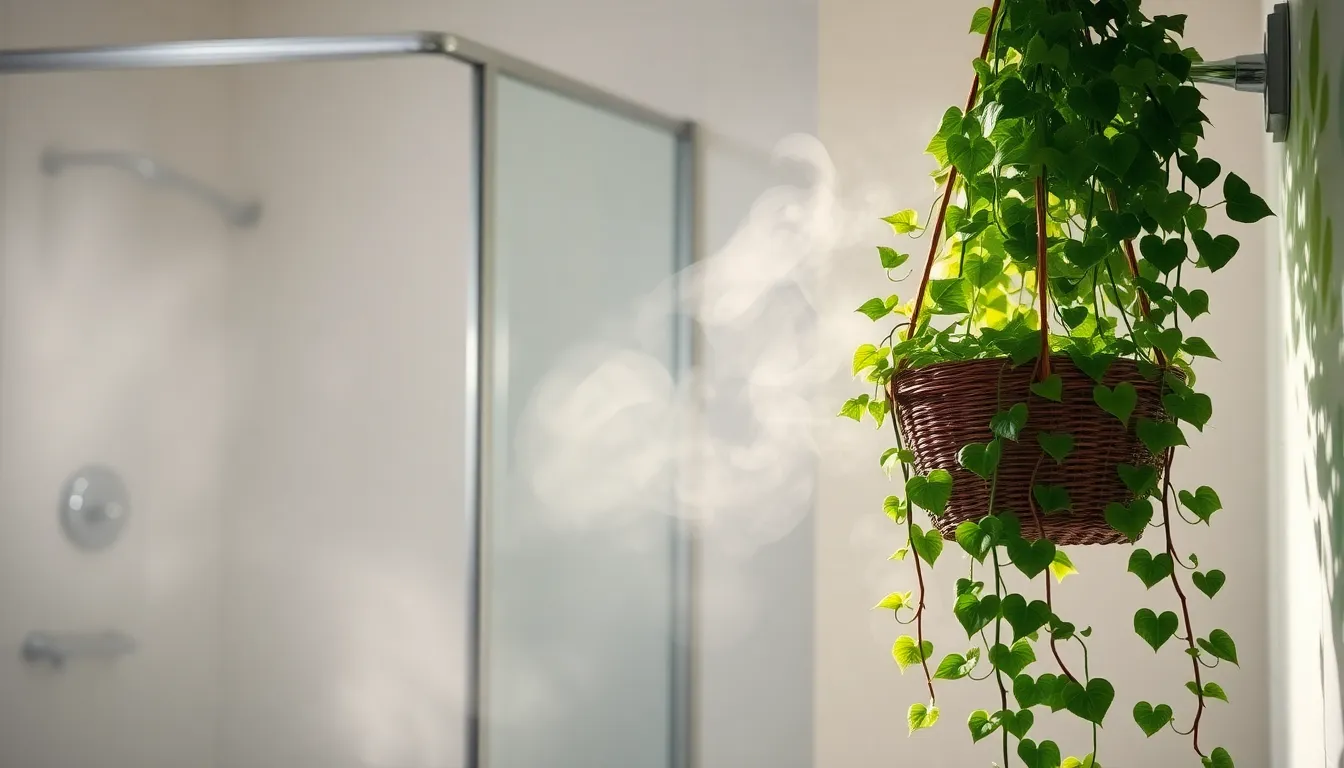
English Ivy stands out as nature’s vigorous moisture absorber that transforms bathroom walls and fixtures into living humidity regulators. This versatile plant combines climbing abilities with exceptional moisture absorption to create healthier bathroom environments.
Trailing Growth Pattern for Shower Areas
Trailing vines make English Ivy perfect for hanging baskets positioned near shower enclosures where steam naturally accumulates. We can place these plants on bathroom shelves or mount them in decorative containers to capture moisture directly from shower activities. The graceful cascading pattern allows ivy to extend into areas where humidity concentrations are highest, maximizing its moisture absorption potential. Positioning trailing English Ivy near shower doors or windows creates natural air purification zones that work continuously to reduce excess dampness.
Mold and Mildew Prevention Properties
Moisture absorption capabilities help English Ivy reduce the ambient humidity that encourages mold and mildew development on bathroom surfaces. We benefit from this plant’s natural ability to lower humidity levels below the threshold where harmful fungi typically thrive. The continuous moisture removal process creates an environment less conducive to bacterial growth and surface damage. English Ivy’s presence significantly reduces the risk of health issues associated with bathroom mold while protecting tile grout and painted surfaces from moisture damage.
Easy Propagation and Maintenance
Propagation from cuttings makes English Ivy one of the most cost effective bathroom plants for homeowners seeking multiple moisture absorbing specimens. We can easily create new plants by cutting healthy vine sections and rooting them in water before transplanting to soil. The plant thrives in indirect bathroom lighting and actually prefers the humid conditions that other houseplants find challenging. Regular watering every few days and occasional trimming keep English Ivy healthy while maintaining its moisture absorption efficiency throughout the year.
Tillandsia Air Plants: Soilless Humidity Absorbers
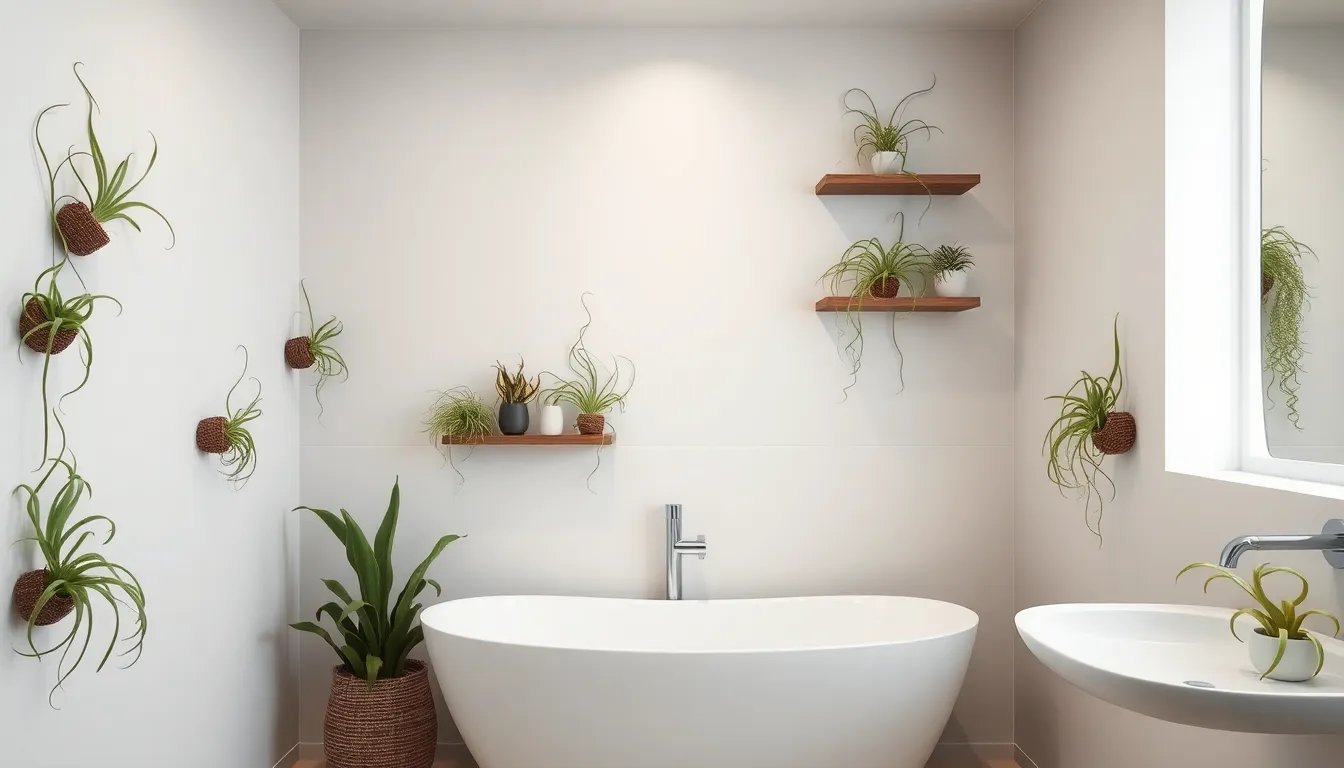
Tillandsia air plants offer a revolutionary approach to bathroom moisture control without the complications of traditional potted plants. These remarkable plants absorb moisture directly from the air through their specialized leaves, making them natural humidity regulators perfectly suited for steamy bathroom environments.
No Soil Requirements for Easy Bathroom Placement
Tillandsia plants thrive without any soil whatsoever, eliminating the mess and maintenance challenges that come with traditional potted plants in bathrooms. We can place these air plants virtually anywhere in our bathrooms without worrying about drainage issues, water damage to surfaces, or soil spillage during cleaning routines.
The absence of soil means we don’t need to deal with fungal growth or bacterial issues that often plague traditional bathroom plants in constantly moist environments. Tillandsia plants absorb water and nutrients directly through their leaves, simplifying placement options significantly since they require no root system anchored in growing medium.
We can attach these versatile plants to bathroom walls, place them on shelves, hang them from shower curtain rods, or even position them near mirrors where they’ll efficiently absorb ambient moisture. Their soilless nature makes them ideal for small bathrooms where space is limited and cleanliness is essential.
Unique Aesthetic Appeal
These sculptural plants bring a modern, minimalist aesthetic to bathroom spaces while actively managing humidity levels throughout the day. Tillandsia air plants feature unique twisted leaves and architectural forms that create visual interest without cluttering bathroom surfaces or requiring decorative pots.
We can display them in creative ways that enhance our bathroom’s design theme, whether we prefer contemporary, rustic, or spa-like atmospheres. The plants’ natural silver-green coloration complements various bathroom color schemes while their organic shapes soften hard bathroom fixtures and surfaces.
Their distinctive appearance transforms functional moisture control into decorative elements that guests often mistake for artistic installations rather than living plants. We can group multiple Tillandsia varieties together to create stunning living displays that serve as focal points while continuously absorbing excess bathroom humidity.
Minimal Maintenance Needs
Tillandsia air plants require remarkably little care compared to traditional bathroom plants, needing only occasional soaking in tap water for a few minutes every other week. We don’t need to monitor soil moisture levels, worry about overwatering, or deal with fertilizer schedules that complicate plant care routines.
These low-maintenance plants perform well in typical bathroom lighting conditions, requiring no special grow lights or sunny windowsills that many other moisture-absorbing plants demand. They continue absorbing humidity and improving air quality even in windowless bathrooms where other plants would struggle to survive.
The plants’ drought-tolerant nature means we can travel without arranging plant-sitting services, and they’ll continue managing bathroom humidity levels effectively during our absence. Their resilience makes them perfect for busy households where consistent plant care routines can be challenging to maintain.
Aloe Vera: Medicinal Moisture Manager
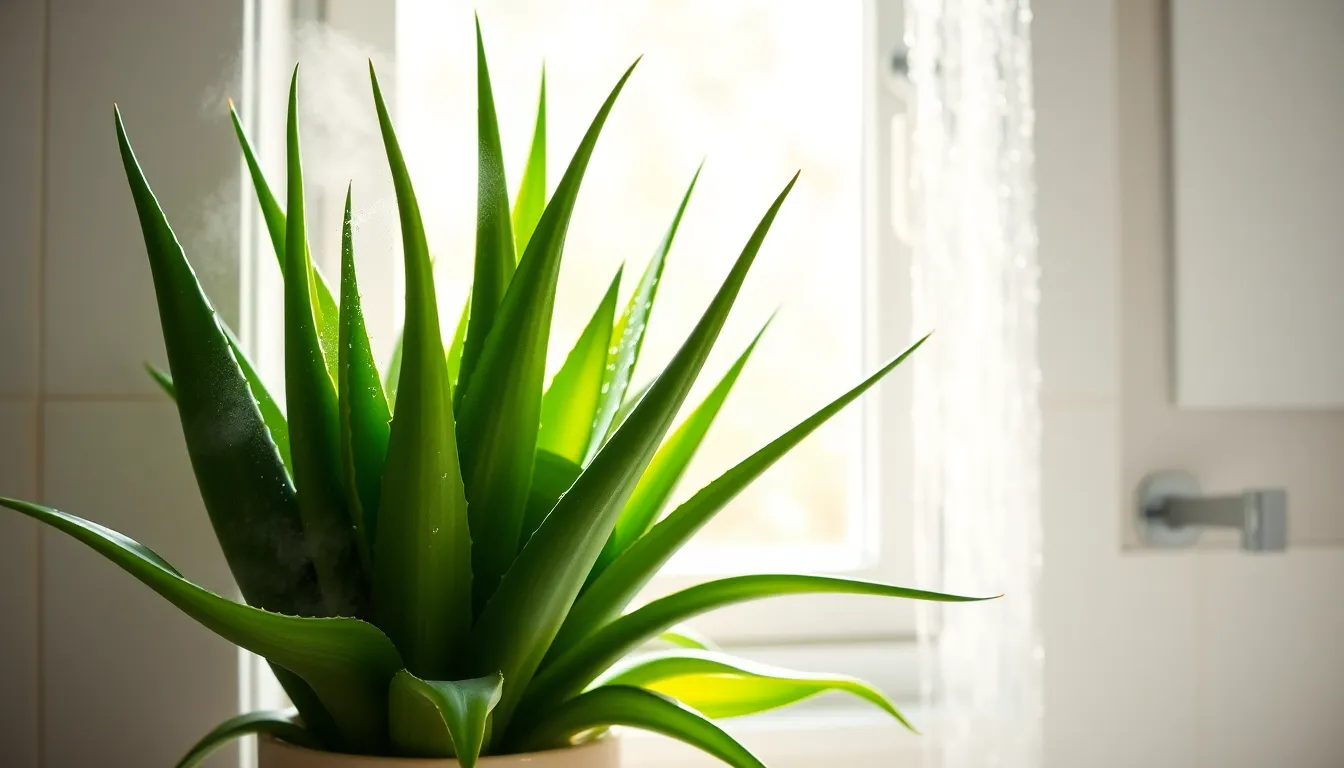
Aloe Vera combines moisture control capabilities with therapeutic skincare benefits, making it the perfect multitasking bathroom companion. This remarkable succulent absorbs excess humidity while providing immediate access to natural skin remedies.
Dual-Purpose Plant for Skincare and Humidity
Skincare benefits make Aloe Vera our top choice for bathroom moisture management. We can break open its thick leaves to access the cooling gel that soothes sunburns, heals minor cuts, and reduces skin irritation after shaving. The plant’s gel contains natural anti-inflammatory compounds that calm redness and itchiness, creating an instant skincare solution right in our bathroom.
Beyond its medicinal properties, Aloe Vera efficiently manages bathroom humidity through its unique moisture absorption system. Regular shower steam provides the ideal environment for this plant to thrive without frequent watering. We benefit from having both a natural dehumidifier and a first-aid remedy growing in the same space.
Succulent Storage of Excess Moisture
Moisture absorption occurs naturally through Aloe Vera’s specialized succulent structure. The plant’s thick, fleshy leaves store water efficiently, allowing it to regulate excess humidity in steamy bathroom environments. Native to arid regions, Aloe Vera has evolved to capture and retain moisture from the air, making it exceptionally well-suited for managing bathroom dampness.
Water storage capacity in these leaves enables the plant to thrive in humid conditions while requiring minimal maintenance from us. We appreciate how the plant’s natural drought tolerance means it actually benefits from the moisture-rich bathroom atmosphere without becoming waterlogged or developing root rot.
Bright Light Tolerance Near Bathroom Windows
Bathroom windows provide the ideal lighting conditions for Aloe Vera’s growth and moisture absorption capabilities. The plant tolerates bright light exposure, making it perfect for placement on windowsills where it receives adequate sunlight for healthy development. We can position our Aloe Vera near windows without worrying about light sensitivity or leaf damage.
Direct sunlight access enhances the plant’s ability to process the moisture it absorbs from bathroom humidity. The combination of natural light and steam from our daily showers creates optimal growing conditions that keep the plant healthy while maximizing its dehumidifying potential. This strategic window placement also makes the medicinal gel easily accessible when we need it for skincare purposes.
Reed Palm: Professional Moisture Solution
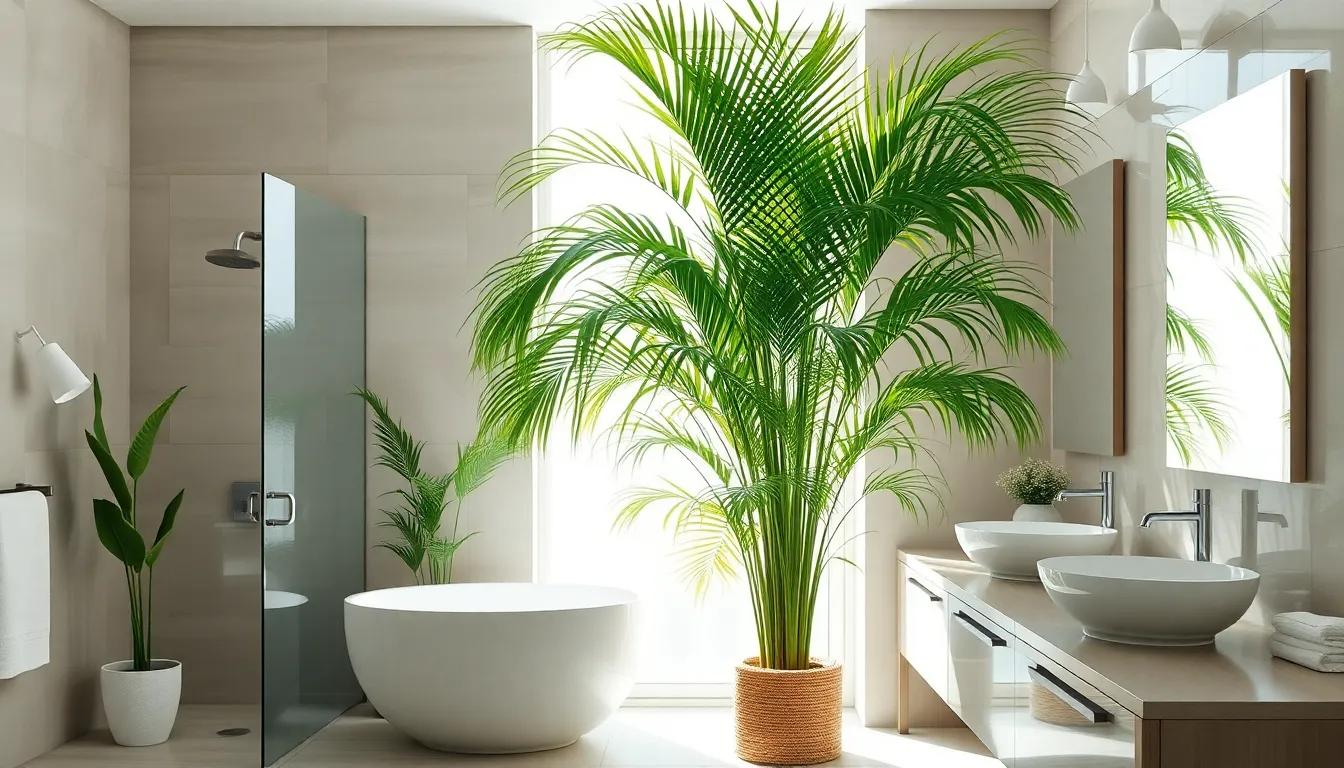
Reed palms represent the professional tier of bathroom humidity control plants. These impressive specimens deliver commercial grade moisture absorption while maintaining the elegant aesthetic we’ve come to expect from premium bathroom botanicals.
Commercial-Grade Humidity Control
Reed palms absorb moisture through their large, glossy leaves with remarkable efficiency. Their professional level performance helps reduce excess humidity and prevents mold formation in bathrooms where standard plants might struggle. We find these palms particularly effective at controlling humidity levels that would challenge lesser moisture absorbing plants. The specialized leaf structure allows reed palms to process important amounts of ambient moisture while keeping bathroom air fresh and considerably less damp than untreated spaces.
Impressive Height for Large Bathrooms
Reed palms grow to notable heights that make them ideal candidates for larger bathroom spaces. Their substantial vertical presence allows these plants to impact both decor and air moisture regulation simultaneously across expansive bathroom areas. We recommend reed palms specifically for homeowners with spacious bathrooms where smaller plants would appear insignificant or fail to address moisture concerns adequately. The impressive stature of mature reed palms creates dramatic focal points while delivering proportional humidity control benefits that match their commanding visual presence.
Low Maintenance Requirements
Reed palms require minimal maintenance even though their professional grade moisture absorption capabilities. These hardy plants thrive exceptionally well in humid bathroom conditions without demanding extensive care routines from busy homeowners. We appreciate how reed palms adapt naturally to steamy environments while maintaining their moisture absorbing effectiveness with basic watering schedules. Their resilient nature means reed palms continue performing their humidity control functions consistently without the frequent attention that other high performance bathroom plants might require.
Conclusion
Transform your bathroom into a healthier more comfortable space by introducing these moisture-absorbing plants into your daily routine. We’ve shown you how these natural dehumidifiers can eliminate excess humidity while creating a spa-like atmosphere that enhances your home’s value and appeal.
Whether you choose low-maintenance options like snake plants or dramatic statement pieces like bamboo palms each selection offers unique benefits that extend far beyond moisture control. These living answers provide year-round humidity management without electricity costs or mechanical maintenance.
Start with one or two plants that match your bathroom’s lighting and space requirements then expand your collection as you experience the remarkable difference they make. Your bathroom will thank you with fresher air better humidity levels and a more inviting environment for years to come.
Frequently Asked Questions
What plants are best for reducing bathroom humidity?
Snake plants, Boston ferns, spider plants, peace lilies, bamboo palms, orchids, English ivy, Tillandsia air plants, aloe vera, and reed palms are excellent choices. These plants naturally absorb moisture from the air while thriving in humid bathroom conditions. They require minimal maintenance and provide both functional humidity control and aesthetic appeal.
How do snake plants help with bathroom moisture?
Snake plants absorb excess humidity through their leaves while filtering harmful toxins like formaldehyde and benzene from the air. They can remove up to 107 different air pollutants and release oxygen at night. These low-maintenance plants thrive in low light and only need watering every 2-4 weeks, making them perfect for bathrooms.
Can Boston ferns survive in humid bathroom conditions?
Yes, Boston ferns thrive in high-moisture environments and are ideal for bathrooms. They absorb significant moisture through their fronds and require minimal care. Display them in hanging baskets to maximize their moisture absorption potential while adding lush greenery to your bathroom space.
Are spider plants good for bathroom air quality?
Spider plants excel in humid bathroom conditions and efficiently absorb moisture through their arching leaves. They grow rapidly in steamy environments and can be easily propagated to create multiple plants from one specimen. Additionally, they filter airborne pollutants, reducing mold risk and creating healthier bathroom environments.
How do peace lilies indicate when they need water?
Peace lilies have a natural watering indicator – their leaves droop when they need water. This feature makes them easy to care for in bathrooms. They produce beautiful white blooms in humid conditions, perform well in low light, and actively manage moisture levels while purifying the air.
What makes bamboo palms effective for large bathrooms?
Bamboo palms have large surface areas that efficiently capture moisture from the air, acting as natural humidifiers. Their substantial size creates dramatic decorative impact in larger bathrooms while maintaining optimal humidity levels. They transform bathrooms into spa-like retreats with their lush tropical foliage.
Why are orchids suitable for bathroom windowsills?
Orchids are epiphytic plants that naturally absorb moisture directly from the air, making them effective dehumidifiers. They thrive on bright, indirect sunlight and consistent humidity from bathroom activities. Orchids reward homeowners with long-lasting, colorful blooms while performing moisture-absorbing duties.
How does English ivy prevent mold in bathrooms?
English ivy reduces ambient humidity levels by absorbing moisture through its trailing growth pattern. It’s perfect for hanging baskets near shower areas where it can maximize moisture absorption. By controlling humidity, it helps prevent mold and mildew formation, creating a healthier bathroom environment.
What are the benefits of Tillandsia air plants in bathrooms?
Tillandsia air plants absorb moisture directly through specialized leaves without needing soil, eliminating mess and maintenance challenges. They require minimal care (only occasional soaking), thrive in typical bathroom lighting, and can be placed anywhere. Their unique aesthetic adds modern appeal while effectively managing humidity.
Can aloe vera provide skincare benefits in bathrooms?
Yes, aloe vera combines moisture control with skincare benefits. While absorbing excess humidity, it provides access to its soothing gel for treating sunburns and minor skin irritations. Its thick leaves store water efficiently, making it well-suited for humid environments and ideal for placement near bathroom windows.

